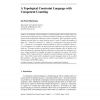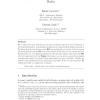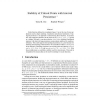132
click to vote
SIAMCOMP
2011
14 years 8 months ago
2011
Set agreement, where processors decisions constitute a set of outputs, is notoriously harder to analyze than consensus where the decisions are restricted to a single output. This ...
116
click to vote
SMI
2010
IEEE
14 years 11 months ago
2010
IEEE
Abstract--Many representation schemes have been proposed to deal with non-manifold and mixed dimensionalities objects. A majority of those models are based on incidence graphs and ...
111
click to vote
JANCL
2002
15 years 20 days ago
2002
A topological constraint language is a formal language whose variables range over certain subsets of topological spaces, and whose nonlogical primitives are interpreted as topologi...
137
click to vote
JCSS
2000
15 years 23 days ago
2000
The paper investigates the use of topological annotations (called topological invariants) to answer topological queries in spatial databases. The focus is on the translation of to...
115
click to vote
TIP
2008
15 years 27 days ago
2008
The implicit framework of the level-set method has several advantages when tracking propagating fronts. Indeed, the evolving contour is embedded in a higher dimensional level-set f...
136
Voted
APAL
2005
15 years 27 days ago
2005
Dynamic Topological Logic provides a context for studying the confluence of the topological semantics for S4, based on topological spaces rather than Kripke frames; topological dy...
140
Voted
ENTCS
2007
15 years 28 days ago
2007
We consider the non-orthodox proof rules of hybrid logic from the viewpoint of topological semantics. Topological semantics is more general than Kripke semantics. We show that the...
124
click to vote
DCG
2007
15 years 29 days ago
2007
Scalar functions defined on a topological space Ω are at the core of many applications such as shape matching, visualization and physical simulations. Topological persistence i...
CORR
2007
Springer
15 years 29 days ago
2007
Springer
We show that for every n > 0 there is a planar topological disk A0 and n translates A1, A2, . . . , An of A0 such that the interiors of A0, . . . An are pairwise disjoint, but ...
120
click to vote
CGF
2006
15 years 1 months ago
2006
Performances of actual mesh compression algorithms vary significantly depending on the type of model it encodes. These methods rely on prior assumptions on the mesh to be efficient...



